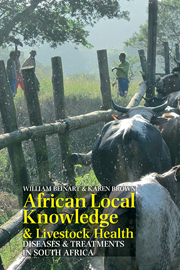Book contents
- Frontmatter
- Contents
- Acknowledgements
- Abbreviations
- Names of Common Diseases
- List of Maps, Photographs & Tables
- 1 Introduction: African Local Knowledge & Veterinary Pluralism
- 2 Ticks, Tick-borne Diseases & the Limits of Local Knowledge Introduction
- 3 ‘The Grave of the Cow is in the Stomach’: Environment & Nutrition in the Explanation & Prevention of Livestock Diseases
- 4 Transhumance, Animal Diseases & Environment
- 5 Plants & Drugs: Medicating Livestock
- 6 Medicinal Plants: Their Selection & their Properties
- 7 Animal Health & Ideas of the Supernatural
- 8 Gender, Space & the Supernatural
- 9 Conclusion
- Appendices
- Select Bibliography
- Index
1 - Introduction: African Local Knowledge & Veterinary Pluralism
Published online by Cambridge University Press: 05 December 2013
- Frontmatter
- Contents
- Acknowledgements
- Abbreviations
- Names of Common Diseases
- List of Maps, Photographs & Tables
- 1 Introduction: African Local Knowledge & Veterinary Pluralism
- 2 Ticks, Tick-borne Diseases & the Limits of Local Knowledge Introduction
- 3 ‘The Grave of the Cow is in the Stomach’: Environment & Nutrition in the Explanation & Prevention of Livestock Diseases
- 4 Transhumance, Animal Diseases & Environment
- 5 Plants & Drugs: Medicating Livestock
- 6 Medicinal Plants: Their Selection & their Properties
- 7 Animal Health & Ideas of the Supernatural
- 8 Gender, Space & the Supernatural
- 9 Conclusion
- Appendices
- Select Bibliography
- Index
Summary
The road from the bustling town of Lusikisiki to the coastal village of Mbotyi in Mpondoland passes through a large tea plantation then twists down a precipitous escarpment through dense indigenous forest. At any point on this route you are likely to find cattle, horses or goats straying across the way. On the beach cattle often roam the sands and dip their hooves in sea water. Green hills with lush pasture sweep up from the shore line. It is a romantic scene, but there is another side to this bucolic idyll. Many of the cattle have parts of their ears eaten away by ticks which are embedded in every orifice from the eyes to the anus. Even the fattest and healthiest of animals can be assailed by these parasites. Richard Msezwa, a local resident in his sixties, recalled: ‘when I was a boy herding you seldom saw ticks in the veld. If you saw a tick you would get excited and call the other herdboys over. Now if you walk through grass your trousers become black with ticks.’ All is not well on South Africa's veld.
South Africa is a land not only of politics and gold but also of animals. Its teeming wildlife, once hunted close to extermination, is now conserved and celebrated in renowned reserves. Wildlife was displaced over a long period by livestock in the hands of Africans and then white settlers. Livestock became central to rural society and until recently many South Africans owned or worked with animals.
- Type
- Chapter
- Information
- African Local Knowledge and Livestock HealthDiseases and Treatments in South Africa, pp. 1 - 31Publisher: Boydell & BrewerPrint publication year: 2013



